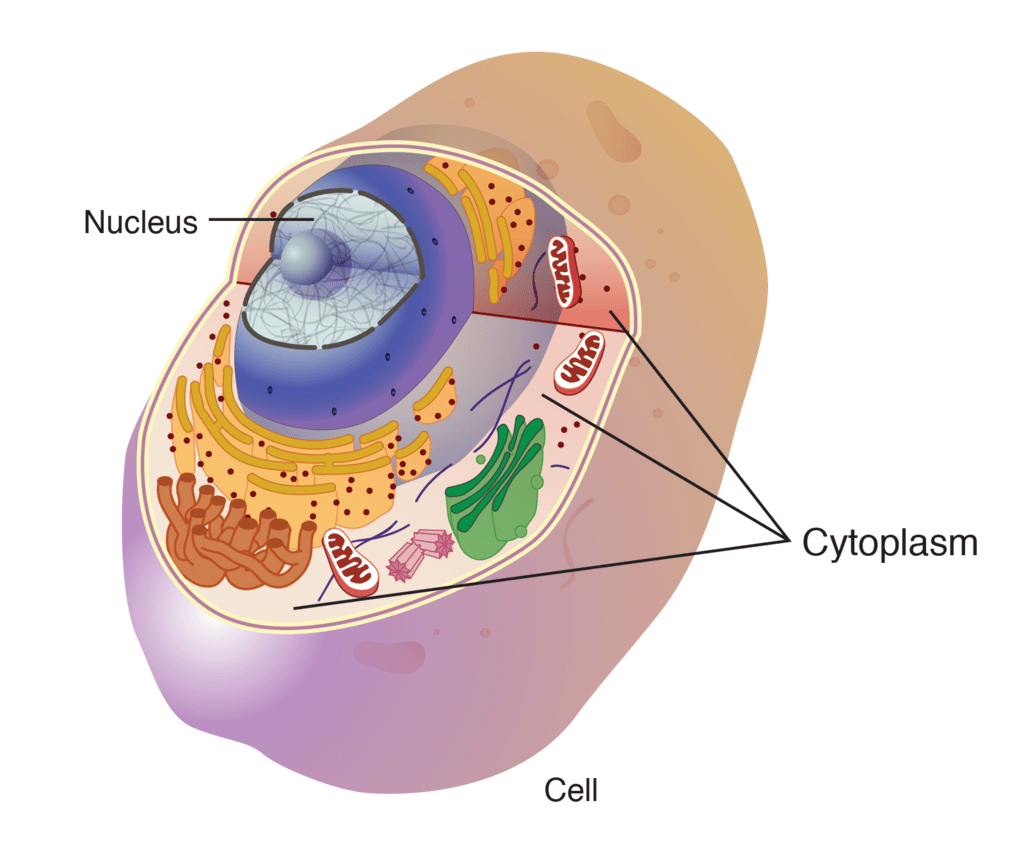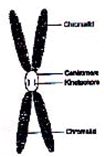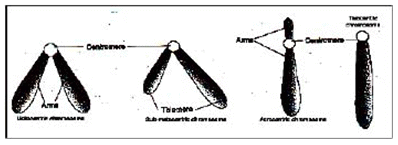Cytoplasm, Cell Organelles and Cell Division | Biology for Grade 9 PDF Download
Cytoplasm

The cytoplasm is a thick, jelly-like, colorless semi-fluid substance present between the plasma membrane and the nuclear membrane. Its watery part is called cytosol, which contains various cell organelles and waste products like starch, glycogen, and lipids.
Functions of Cytoplasm
- Storage: Cytoplasm stores essential chemicals like amino acids, proteins, sugars, and vitamins.
- Metabolic Reactions: It is the site for metabolic reactions such as glycolysis, fatty acid synthesis, and nucleotide synthesis.
Cell Organelles
Cell organelles are specialized structures within a cell that perform specific functions to maintain the cell's life and activities.
1. Golgi Apparatus
- It consists of membrane-bound, fluid-filled vesicles, vacuoles, and flattened sacs called cisternae, usually arranged parallel to one another.
- Functions: To store, modify, package, and dispatch substances.
- It also aids in the synthesis of the cell wall, plasma membrane, and lysosomes, which are formed from fused transport vesicles containing enzymes.
2. Endoplasmic Reticulum
- A membrane network of tube-like structures extending from the nuclear membrane to the plasma membrane, absent in prokaryotic cells and mature red blood cells of mammals.
- Types: (i) Rough Endoplasmic Reticulum (RER): Has ribosomes on its surface for protein synthesis. (ii) Smooth Endoplasmic Reticulum (SER): Lacks ribosomes and is responsible for lipid secretion.
- Functions: Provides internal support, aids in transporting substances between the nuclear and plasma membranes, and involved in protein and lipid synthesis and transport.
3. Ribosomes
- Very small, dense, spherical bodies found free in the cytosol or attached to the endoplasmic reticulum, composed of ribonucleic acid (RNA) and proteins.
- Function: Crucial for protein synthesis.
4. Mitochondria
- Small, rod-shaped organelles with a double membrane; the outer membrane is smooth and porous, while the inner membrane has folds called cristae.
- Contain their own DNA and ribosomes, not found in bacteria or red blood cells of mammals.
- Functions: Sites of cellular respiration, providing energy for vital activities, and storing energy in the form of ATP, known as the 'powerhouse' of the cell.
5. Centrosome and Centrioles
- Centrosomes, present only in eukaryotic animal cells, consist of centrioles, which are not membrane-bound.
- Centrioles are hollow cylinders made of microtubules, arranged at right angles.
- Function: Assist in cell division and in forming cilia and flagella.
6. Plastids
- Found in most plant cells, absent in animal cells, typically spherical or discoidal, surrounded by double membranes, with their own DNA and ribosomes.
- Types: (a) Chloroplasts: Green plastids containing chlorophyll, crucial for photosynthesis. (b) Chromoplasts: Colourful plastids (excluding green). (c) Leucoplasts: Colourless plastids.
- Functions: Chloroplasts: Capture solar energy to produce food for the plant. Chromoplasts: Provide various colours to flowers to attract insects for pollination. Leucoplasts: Store food in the form of starch, proteins, and fats.
7. Lysosomes
- Small, spherical, sac-like structures containing digestive enzymes enclosed in a membrane, found in eukaryotic cells, mainly in animals.
- Functions: Digest foreign substances and worn-out organelles, protect against bacteria and viruses, help maintain cell cleanliness, and may burst to digest the cell itself, hence called the suicide bags of a cell.
8. Vacuoles
- Membrane-bound organelles filled with liquid or solid substances, large and permanent in plant cells, small and temporary in animal cells.
- In mature plant cells, vacuoles can occupy 90% of the cell's volume, pushing other organelles, including the nucleus, towards the plasma membrane.
Functions of Cell Organelles
- Cell Organelles are specialized structures within a cell that perform specific functions.
- They are essential for the proper functioning and maintenance of the cell.
Functions of Cell Organelles in Detail
1. Nucleus. The nucleus is the control center of the cell. It contains the cell's genetic material (DNA) and regulates all cellular activities, including growth, metabolism, and reproduction. The nucleus is also responsible for producing ribosomes, which are essential for protein synthesis.
2. Ribosomes. Ribosomes are the protein factories of the cell. They are responsible for synthesizing proteins by translating the genetic code carried by messenger RNA (mRNA). Proteins are essential for various cellular functions, including enzyme activity, structural support, and signaling.
3. Endoplasmic Reticulum (ER). The endoplasmic reticulum is a network of membranes involved in the synthesis, folding, modification, and transport of proteins and lipids. There are two types of ER: (a) Rough ER, which has ribosomes on its surface and is involved in protein synthesis, and (b) Smooth ER, which is involved in lipid synthesis and detoxification.
4. Golgi Apparatus. The Golgi apparatus is responsible for modifying, sorting, and packaging proteins and lipids for transport to their final destinations within or outside the cell. It acts as a processing and shipping center for cellular products.
5. Mitochondria. Mitochondria are known as the powerhouse of the cell. They generate adenosine triphosphate (ATP), the cell's primary energy currency, through cellular respiration. ATP provides the energy needed for various cellular processes, including muscle contraction, nerve impulse transmission, and biosynthesis.
6. Lysosomes. Lysosomes are the cell's recycling centers. They contain digestive enzymes that break down waste materials, cellular debris, and foreign substances. This process, known as autophagy, helps maintain cellular health by removing unwanted components.
7. Peroxisomes. Peroxisomes are involved in the breakdown of fatty acids and the detoxification of harmful substances, such as hydrogen peroxide. They contain enzymes that facilitate these oxidative reactions, contributing to cellular metabolism and detoxification.
8. Cytoskeleton. The cytoskeleton is a network of protein filaments and tubules that provide structural support to the cell, maintain its shape, and facilitate cellular movement. It also plays a crucial role in cell division and the transport of organelles within the cell.
9. Plasma Membrane. The plasma membrane is the outer boundary of the cell, regulating the entry and exit of substances. It is selectively permeable, allowing essential nutrients to enter and waste products to exit while maintaining the cell's internal environment.
10. Vacuoles. Vacuoles are storage compartments within the cell. They store various substances, including nutrients, waste products, and pigments. In plant cells, vacuoles also play a role in maintaining turgor pressure, which helps support the cell's structure.
Conclusion
Cell organelles perform a wide range of functions, from energy production and protein synthesis to waste disposal and cellular communication. Each organelle plays a vital role in ensuring the cell's survival, growth, and proper functioning. Understanding the functions of cell organelles is fundamental to comprehending the intricacies of cellular biology and the basis of life itself.
Cell Organelles. Functions of Cell Organelles
Introduction
- Cell organelles are specialized structures within a cell that perform specific functions necessary for the cell's survival and proper functioning.
- Each organelle has a unique role, and together they work to maintain the cell's health and activity.
- Understanding the functions of cell organelles is crucial for comprehending how cells operate and contribute to the overall functioning of living organisms.
Functions of Cell Organelles
- Nucleus: The nucleus is the control center of the cell. It contains the cell's genetic material (DNA) and regulates all cellular activities, including growth, metabolism, and reproduction. The nucleus is also responsible for producing ribosomes, which are essential for protein synthesis.
- Ribosomes: Ribosomes are the protein factories of the cell. They are responsible for synthesizing proteins by translating the genetic code carried by messenger RNA (mRNA). Proteins are essential for various cellular functions, including enzyme activity, structural support, and signaling.
- Endoplasmic Reticulum (ER): The endoplasmic reticulum is a network of membranes involved in the synthesis, folding, modification, and transport of proteins and lipids. There are two types of ER: (a) Rough ER, which has ribosomes on its surface and is involved in protein synthesis, and (b) Smooth ER, which is involved in lipid synthesis and detoxification.
- Golgi Apparatus: The Golgi apparatus is responsible for modifying, sorting, and packaging proteins and lipids for transport to their final destinations within or outside the cell. It acts as a processing and shipping center for cellular products.
- Mitochondria: Mitochondria are known as the powerhouse of the cell. They generate adenosine triphosphate (ATP), the cell's primary energy currency, through cellular respiration. ATP provides the energy needed for various cellular processes, including muscle contraction, nerve impulse transmission, and biosynthesis.
- Lysosomes: Lysosomes are the cell's recycling centers. They contain digestive enzymes that break down waste materials, cellular debris, and foreign substances. This process, known as autophagy, helps maintain cellular health by removing unwanted components.
- Peroxisomes: Peroxisomes are involved in the breakdown of fatty acids and the detoxification of harmful substances, such as hydrogen peroxide. They contain enzymes that facilitate these oxidative reactions, contributing to cellular metabolism and detoxification.
- Cytoskeleton: The cytoskeleton is a network of protein filaments and tubules that provide structural support to the cell, maintain its shape, and facilitate cellular movement. It also plays a crucial role in cell division and the transport of organelles within the cell.
- Plasma Membrane: The plasma membrane is the outer boundary of the cell, regulating the entry and exit of substances. It is selectively permeable, allowing essential nutrients to enter and waste products to exit while maintaining the cell's internal environment.
- Vacuoles: Vacuoles are storage compartments within the cell. They store various substances, including nutrients, waste products, and pigments. In plant cells, vacuoles also play a role in maintaining turgor pressure, which helps support the cell's structure.
Conclusion
Cell organelles perform a wide range of functions, from energy production and protein synthesis to waste disposal and cellular communication. Each organelle plays a vital role in ensuring the cell's survival, growth, and proper functioning. Understanding the functions of cell organelles is fundamental to comprehending the intricacies of cellular biology and the basis of life itself.
Chromosome


At the time of cell division the chromatin threads separate apart from one another and become smaller and thicker, are called chromosome.
A chromosome is a deeply staining, rodlike structure with a part that is usually constricted. This is the point of primary constriction called the centromere.
The chromosomes are defined by their length and the position of centromeres
- If the position of the centromere is such that the two arms of the chromosomes are equal then it is called metacentric.
- If one of the arms of the chromosome is smaller than the other, it is called submetacentric.
- If one arm of the chromosome is considerably smaller than the other, this straight chromosome is called acrocentric.
- When the centromere occupies one end of the chromosome, it is called telocentric.
The tips of chromosomes are called telomeres.
Prokaryotic Chromosomes
Prokaryotic Chromosomes are composed of DNA. But they are circular as the two ends of the DNA are joined. There is only one chromosome in a prokaryotic cell. This chromosome is not complexed with proteins (histones and acidic proteins), which is a characteristic of eukaryotic chromosomes.
Eukaryotic Chromosome
Eukaryotic chromosome results from the condensation of the chromatin, which happens only during the early part of cell division. In this condensed state its genes are not active.
Number of Chromosomes
The number of chromosomes within the nucleus is constant in all individuals of a given species. For example, there are 46 chromosomes in a human being ; 40 in a mouse ; 8 in a fruitfly (Drosophila melanogaster) ; 20 in maize ; 24 in tomato and 48 in potato. As it represents two sets of chromosomes, one set received from each parent, this number is called the diploid number of chromosomes. The nucleus of a gamete (egg or sperm) contains half this number of chromosomes, or the haploid number. Thus a human gamete contains 23 chromosomes. A haploid set of chromosomes is called genome.
Do you know?
- Chromatin threads are made up of
(i) DNA (ii) Protein [Histone protein] - Gene: The segment of DNA and act as unit of heredity
ATP(Adenosine triphosphate)
It is also known as energy currency. It provides energy to perform bio-synthesis & mechanical work.
- Homologous Chromosomes: All chromosomes are found in pair and the chromosomes of a pair are called homologous chromosomes.
- Non-homologous Chromosomes: Chromosomes of different pair.
- The nucleus of prokaryotes is also known nucleoid.
- Nucleus is also called director of cell as it controls most of the cellular activities.
- Nucleus is absent in sieve tubes of vascular plants & mature RBC's of mammals. Mammalian RBC also lacks Golgibodies, mitochondria, ER, lysosomes.
|
50 videos|96 docs|27 tests
|
FAQs on Cytoplasm, Cell Organelles and Cell Division - Biology for Grade 9
| 1. What is cytoplasm and what are its functions? |  |
| 2. What is the role of chromosomes in cell division? |  |
| 3. What are cell organelles and why are they important? |  |
| 4. How does the cytoplasm contribute to cell metabolism? |  |
| 5. How does cell division contribute to the growth and development of organisms? |  |





















